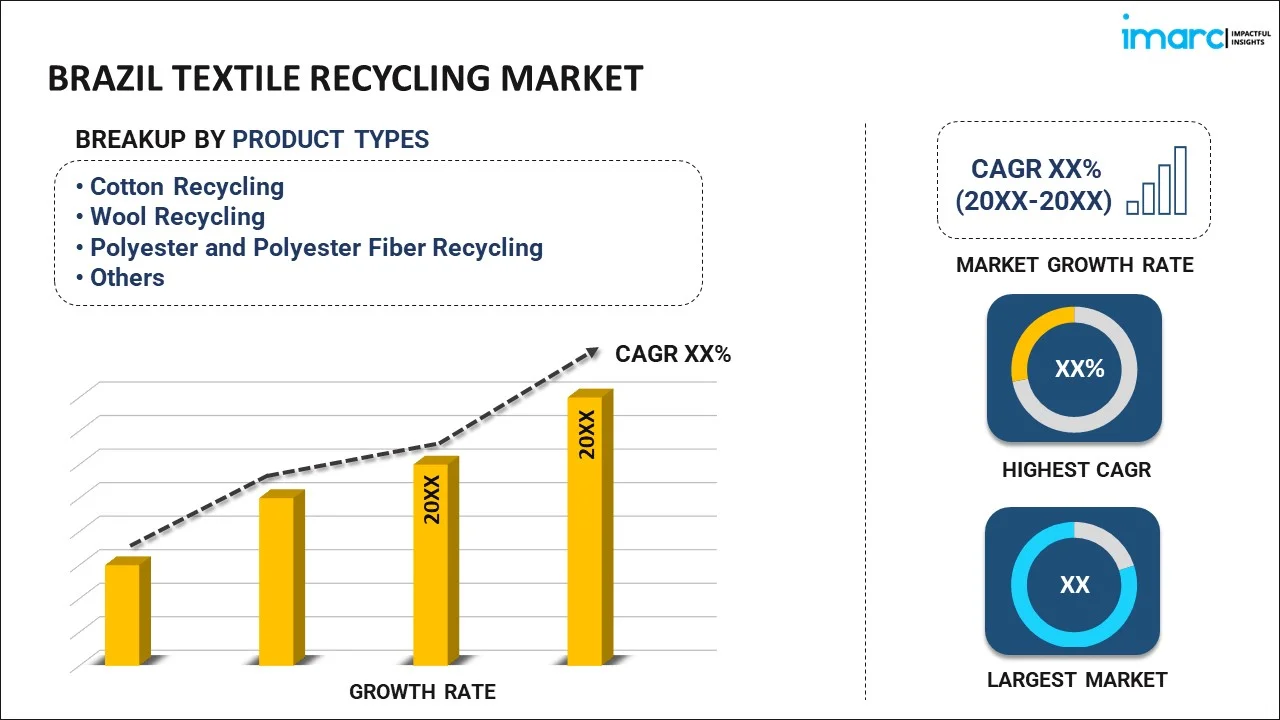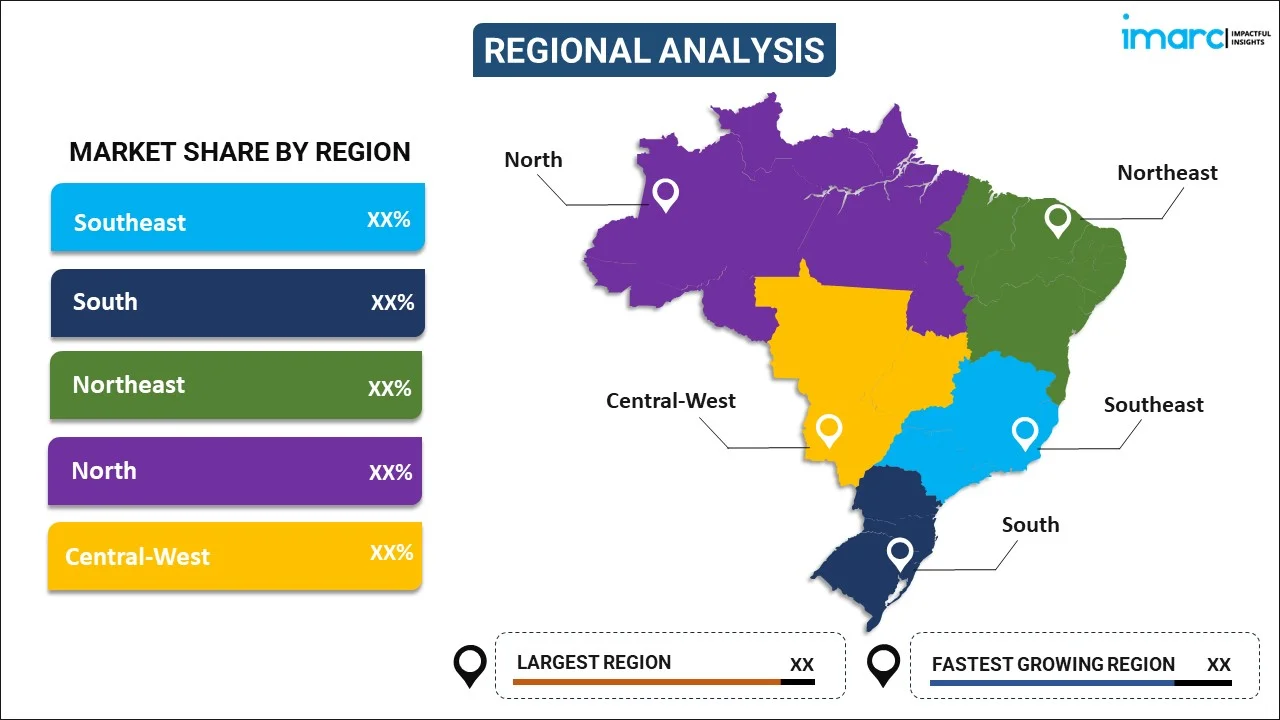
Brazil Textile Recycling Market Report by Product Type (Cotton Recycling, Wool Recycling, Polyester and Polyester Fiber Recycling, Nylon and Nylon Fiber Recycling, and Others), Textile Waste (Pre-consumer Textile, Post-consumer Textile), Distribution Channel (Online Channel, Retail and Departmental Store), End User (Apparel, Industrial, Home Furnishings, Non-woven, and Others), and Region 2026-2034
Brazil Textile Recycling Market Overview:
The Brazil textile recycling market size reached USD 97.5 Million in 2025. Looking forward, IMARC Group expects the market to reach USD 166.8 Million by 2034, exhibiting a growth rate (CAGR) of 6.15% during 2026-2034. The growing textile and fashion industry in the country, rising awareness about sustainability among consumers, the implementation of several government policies, and the widespread adoption of circular economy principles represent some of the key factors driving the market.
|
Report Attribute
|
Key Statistics
|
|---|---|
|
Base Year
|
2025
|
|
Forecast Years
|
2026-2034
|
|
Historical Years
|
2020-2025
|
|
Market Size in 2025
|
USD 97.5 Million |
|
Market Forecast in 2034
|
USD 166.8 Million |
| Market Growth Rate 2026-2034 | 6.15% |
Textile recycling refers to the process of recovering fiber, yarn, or fabric and reprocessing the textile material into useful products. It is an integral component of the circular economy that aims at reducing landfill waste, saving resources, and minimizing the environmental impact of textile production. Textile recycling is categorized into pre-consumer and post-consumer variations. It is available in various types of materials, like cotton, wool, silk, and synthetic fibers like polyester and nylon, which are transformed into multiple products, such as cleaning cloths, insulation materials, automotive supplies, and new garments. Textile recycling finds extensive applications in various sectors, such as industrial, consumer goods, second-hand clothing, home furnishings, and agriculture. It provides numerous benefits, including the conservation of raw materials, reduced energy consumption, and diminished pollution levels. Moreover, textile recycling promotes sustainable fashion, supports green jobs, and fosters innovation in recycling technologies.
Brazil Textile Recycling Market Trends:
Expansion of the Textile and Apparel Sector
Brazil’s textile and fashion industry has seen steady growth, with more brands, designers, and manufacturers entering the space. As production volumes increase, so does the volume of textile waste, ranging from pre-consumer scraps to post-consumer garments. This rise in output creates more pressure on waste management systems and has pushed textile scrap recycling higher on the agenda. Local brands, especially those focused on sustainable production, are now exploring closed-loop models and circular design. The demand for alternatives to landfill disposal has opened opportunities for recyclers. Businesses involved in fiber-to-fiber recycling, mechanical shredding, and reprocessing are seeing higher demand. The textile manufacturing market in Brazil is indirectly fueling innovation and investment in recycling infrastructure across the country.
Rising Consumer Awareness around Waste
There’s a noticeable shift in how Brazilian consumers think about fashion and waste. Shoppers are asking more questions about what happens to clothes after use, pushing brands to take responsibility for the full lifecycle of their products. Social media, sustainability campaigns, and educational content are helping people understand the impact of textile waste. Donation bins, clothing recycling drives, and second-hand markets are also gaining traction. This mindset shift is creating a steady stream of used garments that are now being collected instead of discarded. As demand grows for sustainable options, textile recyclers are tapping into a larger, more willing pool of contributors who are looking for ways to reduce their environmental footprint.
Policy Push for Recycling Integration
Brazil’s government has started tightening its focus on waste management and sustainability, and the textile sector is under the microscope. National programs, such as reverse logistics mandates and extended producer responsibility, are bringing recycling into the regulatory fold. Brands are now required to find ways to handle textile waste and prove compliance. Some local governments are introducing textile-specific waste collection programs, while others are funding pilot projects for recycling facilities. The Brazil textile market is beginning to reflect this policy-driven shift, with increased emphasis on sustainable practices. In parallel, demand for Brazil textile chemicals used in eco-friendly processing and waste treatment is also increasing. Public-private collaborations are key to building momentum in this area.
Technology Driving Better Material Recovery
Recycling textiles used to be limited by poor sorting, contamination, and limited fiber reuse. New technologies are changing that. Advanced sorting systems can now separate materials by fiber type using AI and near-infrared sensors. Chemical recycling methods are being tested to handle blended fabrics that couldn’t be recycled before. Brazilian startups and academic labs are joining the effort, working on ways to process cotton, Brazil synthetic fibers, and other textiles more efficiently. These tech improvements mean less material is downgraded and more can be reintroduced into high-quality manufacturing. The development of smart systems that handle Brazil textile fabrics is accelerating progress. As these solutions scale up, they’re likely to improve quality and cost-efficiency for the recycling supply chain.
Brazil Textile Recycling Market Segmentation:
IMARC Group provides an analysis of the key trends in each segment of the market, along with forecasts at the country level for 2026-2034. Our report has categorized the market based on product type, textile waste, distribution channel, and end user.
Product Type Insights:

To get more information on this market, Request Sample
- Cotton Recycling
- Wool Recycling
- Polyester and Polyester Fiber Recycling
- Nylon and Nylon Fiber Recycling
- Others
The report has provided a detailed breakup and analysis of the market based on the product type. This includes cotton recycling, wool recycling, polyester and polyester fiber recycling, nylon and nylon fiber recycling, and others.
Textile Waste Insights:
- Pre-consumer Textile
- Post-consumer Textile
A detailed breakup and analysis of the market based on the textile waste have also been provided in the report. This includes pre-consumer textile and post-consumer textile.
Distribution Channel Insights:
- Online Channel
- Retail and Departmental Store
The report has provided a detailed breakup and analysis of the market based on the distribution channel. This includes online channel and retail and departmental store.
End User Insights:
- Apparel
- Industrial
- Home Furnishings
- Non-woven
- Others
A detailed breakup and analysis of the market based on the end user have also been provided in the report. This includes apparel, industrial, home furnishings, non-woven, and others.
Regional Insights:

- Southeast
- South
- Northeast
- North
- Central-West
The report has also provided a comprehensive analysis of all the major regional markets, which include Southeast, South, Northeast, North, and Central-West.
Competitive Landscape:
The market research report has also provided a comprehensive analysis of the competitive landscape. Competitive analysis such as market structure, key player positioning, top winning strategies, competitive dashboard, and company evaluation quadrant has been covered in the report. Also, detailed profiles of all major companies have been provided.
Brazil Textile Recycling Market Report Coverage:
| Report Features | Details |
|---|---|
| Base Year of the Analysis | 2025 |
| Historical Period | 2020-2025 |
| Forecast Period | 2026-2034 |
| Units | Million USD |
| Scope of the Report | Exploration of Historical and Forecast Trends, Industry Catalysts and Challenges, Segment-Wise Historical and Predictive Market Assessment:
|
| Product Types Covered | Cotton Recycling, Wool Recycling, Polyester and Polyester Fiber Recycling, Nylon and Nylon Fiber Recycling, Others |
| Textile Wastes Covered | Pre-consumer Textile, Post-consumer Textile |
| Distribution Channels Covered | Online Channel, Retail and Departmental Store |
| End Users Covered | Apparel, Industrial, Home Furnishings, Non-woven, Others |
| Regions Covered | Southeast, South, Northeast, North, Central-West |
| Customization Scope | 10% Free Customization |
| Post-Sale Analyst Support | 10-12 Weeks |
| Delivery Format | PDF and Excel through Email (We can also provide the editable version of the report in PPT/Word format on special request) |
Key Benefits for Stakeholders:
- IMARC’s industry report offers a comprehensive quantitative analysis of various market segments, historical and current market trends, market forecasts, and dynamics of the Brazil textile recycling market from 2020-2034.
- The research report provides the latest information on the market drivers, challenges, and opportunities in the Brazil textile recycling market.
- Porter's five forces analysis assist stakeholders in assessing the impact of new entrants, competitive rivalry, supplier power, buyer power, and the threat of substitution. It helps stakeholders to analyze the level of competition within the Brazil textile recycling industry and its attractiveness.
- Competitive landscape allows stakeholders to understand their competitive environment and provides an insight into the current positions of key players in the market.
Key Questions Answered in This Report
The textile recycling market in Brazil was valued at USD 97.5 Million in 2025.
The Brazil textile recycling market is projected to exhibit a CAGR of 6.15% during 2026-2034, reaching a value of USD 166.8 Million by 2034.
The Brazil textile recycling market is driven by rising demand for sustainable fashion, rapid growth in textile production leading to higher waste volumes, and supportive regulations like Extended Producer Responsibility. Advancements in recycling technologies and increasing adoption of circular economy practices by brands and manufacturers also play a major role.
Need more help?
- Speak to our experienced analysts for insights on the current market scenarios.
- Include additional segments and countries to customize the report as per your requirement.
- Gain an unparalleled competitive advantage in your domain by understanding how to utilize the report and positively impacting your operations and revenue.
- For further assistance, please connect with our analysts.
 Request Customization
Request Customization
 Speak to an Analyst
Speak to an Analyst
 Request Brochure
Request Brochure
 Inquire Before Buying
Inquire Before Buying




.webp)




.webp)












